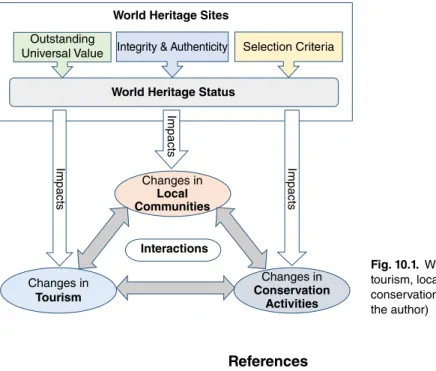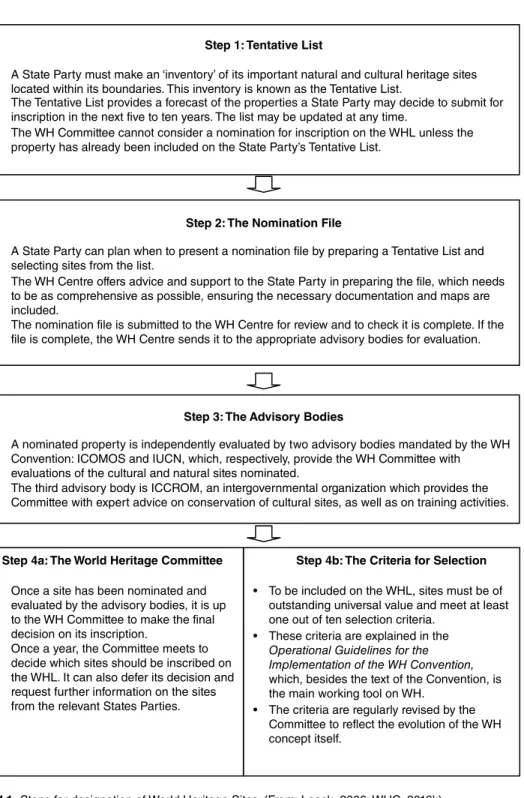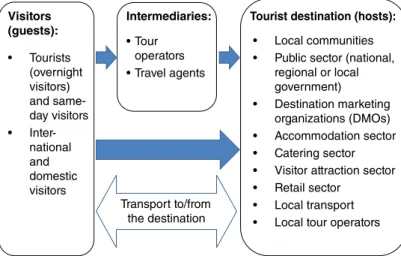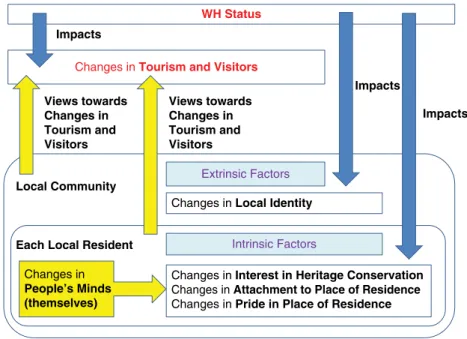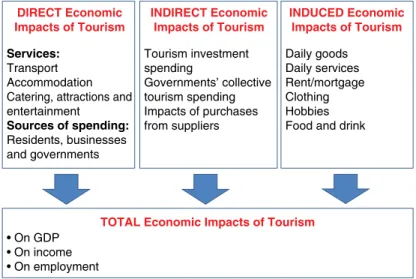Title: World Heritage Sites : tourism, local communities and conservation activities / Takamitsu Jimura, Liverpool John Moores University, UK. LWHD List of World Heritage in Danger MNC multinational corporation MoW Memory of the World.
UNESCO World Heritage Centre The United Nations Educational, Scientific and
Third, many WHSs are located in or around local communities, and in some cases local people even live in WHSs. The post-listing effects of WHS listing and tourism on local communities are also being explored.
World Heritage Committee The World Heritage Committee was established
In 1994, for example, a report to the Committee highlighted that listed cultural WHSs were biased in favor of Europe, historic towns, religious buildings and Christianity, and against prehistory, the 20th century, indigenous artefacts and living traditional cultures (Graham et al., 2000). To remedy these problems, the Committee requested more advanced countries to slow down their pace of nomination (Kammeier, 2003).
States Parties
Advisory bodies
In 1972, UNESCO formalized the concept of WH by adopting the WH Convention. Encouraging participation of the local population in the preservation of their cultural and natural heritage; And.
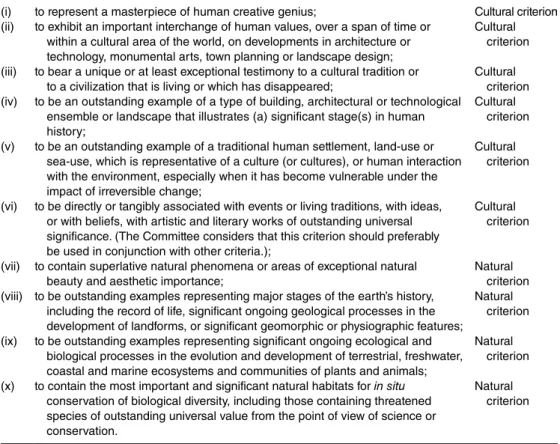
Tentative List
The Nomination File
The Advisory Bodies
Societies and communities Generally, Asian societies tend to be more work-
Although this trend has recently been changing in Japan and other developed Asian countries, this is still true when comparing working hours in the East (mainly South Korea and Japan) with those in the West (mainly France and Germany). This trend may be related to a decline in the sense of community or weakened ties between local populations in these countries.
Culture and religion
The same person goes to another Shinto shrine and prays to the deity of study (gakumon-no-kami) before his exam. Japan's most important characteristic would be 'the way it finds, in a way that we [the British] do not, the confidence to absorb the Cultural Revolution ... Nothing in Japan stands still for a moment' (Spencer, 1991, p. 17).
Heritage and authenticity The Japanese attitude towards authenticity is
For example, a Japanese person visits a Shinto shrine and prays to the mountain god (yama-no-kami) for his/her safety before climbing a mountain. In 2016, Chinese officials were blamed for the repairs to the Great Wall of China (Cultural WHS), which left part of the ancient structure smoothed and resembling a concrete path (BBC News, 2016).
Conservation: culture and nature Regarding culture, there was a comparatively
Cities and planning
In Japan, it is also challenging to establish a consensus on the appearance of building exteriors for the aesthetic quality of the built environment, as the rights of the individual are quite strong. This problem may be associated with limited awareness of the importance of the appearance of buildings.
Visitors and tourism
The impact of World Heritage Site designation on local communities – a comparative study of Ogimachi (Japan) and Saltaire (UK). 2016a) Re-examining the relationship between World Heritage Site designation and local identity. eds) Heritage 2016: Heritage and Sustainable Development.
Heritage management and World Heritage Sites
Conservation activities and World Heritage Sites
Updated information on the WHS should also include a periodic report to record any changes in the conservation status of the WHS (WHC, 2017d). It should also be emphasized that the idea of postmodernism (and modernism) originates from the West.
Overview
WHSs must follow the Operational Guidelines for heritage management, and the Reporting and Monitoring Scheme in their conservation activities. At the same time, however, 'local' knowledge, approaches and techniques specific to each WHS must still be respected and applied to the management and conservation of WHSs as much as possible within the framework of the Operational Guidelines and the Reporting and Monitoring System.
Philosophy and approach Scott (2002) has an insight into the nature of
On the other hand, Tomlinson (1999) argues that globalization does not necessarily lead to such homogenization or creation of a 'global' culture, and that the essence of globalization lies in the highly developed network of interconnections and interdependencies that an international 'stream' of almost everything across borders. Ashworth and Tunbridge (2000) also argue that this danger of standardization must be accepted, but that it is possible to avoid such a danger.
Duties and responsibilities WHS designation and WH status could bring a
In relation to the above arguments, they are a key subject whose views, understanding and interpretation of heritage should be reflected and represented as they can form part of the OUV WHS. One such problem is that, in reality, only the poorest Contracting States can obtain financial assistance through the WHF, and rich Contracting States are unlikely to obtain such financial support, as the resources of the WHF are clearly limited (Brumann, 2014).
Management, conservation and tourism
In addition to balancing heritage conservation and tourism, WHS managers may also face a dilemma regarding the need to balance the wishes of local people and the demands of visitors. As these two groups are likely to have different views on the WHS and its management, WHS managers should anticipate a possible conflict of values and behavior between local people and visitors (ICOMOS International Committee on Cultural Tourism, 1999) and should find a way to reconcile such different aspirations.
Eastern and western perspectives
2003) Visitor management – as a professional responsibility of various site managers (Maritime Greenwich – World Heritage Site). 2016b) Managing world heritage sites: a case study of sacred sites and pilgrimage routes in the Kii Range, Japan.
Economic aspect of the triple bottom line of sustainability
This trend in development theories can also be confirmed in theories and practices in tourism development. Therefore, in this section, tourism development is examined from each pillar of the TBL.
Sociocultural aspect of the triple bottom line of sustainability and tourism
Community sense – tourism can strengthen or weaken ties between local people and community cohesion. Interaction between local people and visitors – tourism can lead to mutual understanding between local residents and visitors, and in some cases can lead to demonstration effects, cultural drift and acculturation in local communities.
Environmental aspect of the triple bottom line of sustainability and tourism
Pollution - this is one of the most common environmental issues caused or exacerbated by tourism development. At the same time, however, it is also true that tourism can raise the awareness of local people and visitors about the preservation of the natural environment.
Tourism development: then and now In relation to tourism thought, approaches and
A variety of built environments, specifically infrastructure, serve day trippers and tourists as well as local communities. However, in light of the environmental aspect of the TBL, the needs of local people must be prioritized taking into account the impact of the man-made environment on the natural environment.
Introduction
The next section considers tourism development specifically on WHSs, and demonstrates the issues unique to, or observable at, WHSs. Accordingly, this section examines tourism development at WHSs from both the host (production and supply) and guest (consumption and demand) sides of tourism.
Tourism development at World Heritage Sites: host side of tourism
In the real world, on the other hand, how are tourism development and/or management and WHS interrelated and integrated in practice. In relation to WHS tourism development, in general, a WHS conservation plan tends to come first, followed by a tourism development and/or management plan.
Tourism development at World Heritage Sites: guest
Both positive and negative implications of tourism development can be examined through each pillar of the TBL of sustainability. A critical evaluation of the global award: the meaning of World Heritage Site status for Maritime Greenwich.
Marketing for tourism
In the light of these points, the image and text content in tourism marketing should be developed. However, the emergence and development of the Internet dramatically changed the role and influence of image and text content in tourism marketing.
Destination marketing Different terms are used to describe ‘places’ visi-
For example, firstly, Madara Rider (cultural WHS in Bulgaria) and Hiroshima Peace Memorial (Genbaku Dome) (cultural WHS in Japan) (see Fig. 4.1) can be seen as 'objects'. Third, the Okavango Delta (natural WHS in Botswana) and Costiera Amalfitana (cultural WHS in Italy) (Fig. 4.3) can be seen as 'destinations'.
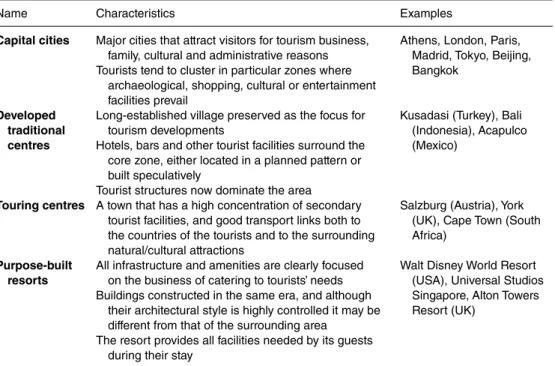
Stakeholders and organizations in marketing for World Heritage Sites
According to Morgan et al. 2011), moreover, the abbreviation DMO can mean not only "destination marketing organization", but also. Considering the historical flow of the above arguments, nowadays DMOs are expected to play a leading role in destination management as well as destination marketing.
Visitors’ responses to World Heritage status
San Diego, California, Sept., pp. 2002) Living in a World Heritage City: Stakeholders in the Dialectic of the Universal and the Particular. 2016) World Heritage Sites Management: A Case Study of Sacred Sites and Pilgrimage Routes in the Kii Mountains, Japan.
Community development and tourism
Before that, Section 4 examines the impact of WHS designation and tourism to WHS listing on local people's minds, which in this book are called 'attitudinal changes'. These studies apply this theory to tourism contexts (e.g. Rasoolimanesh et al., 2015) to examine local people's support for tourism development.
Local people and their views There is a range of issues associated with local
Therefore, this book only addresses the economic, socio-cultural, environmental and attitude effects of WHS listing and tourism after WHS designation on local communities, focusing on local people's views of them. Thinking about what local people really want is necessary not only to gain their support for tourism, but also to keep them in the local community (Jaafar et al., 2016).
Extrinsic and intrinsic factors The factors affecting people’s attitudes towards
Other studies argue that the level of education of the local population is related to their perception of tourism (Andriotis and Vaughan, 2003). In addition, Section 4 explores the impacts of WHS listing on local people's awareness (attitudinal changes).
Attitudes towards tourists and excursionists
The climax of this chapter is the examination of the changes in the minds of local people caused by WHS status and tourism following WHS enrollment (attitudinal changes). Nevertheless, understanding changes in local residents' attitudes caused by WH status or tourism following WHS listing is vital to their support for tourism development and conservation activities at WHSs.
Interest in heritage conservation As tourism can work as an impetus for awakening
Morgan (2002) also argues that there is a positive relationship between the length of stay of local residents and the degree of interest in heritage conservation. Orbasli (2000) even argues that WHS enrollment can increase local residents' interest in their city.
Attachment to place of residence According to Ennen (2000), local residents’ at-
The closer the local residents live to the WHS, the higher the local residents' interest in conservation since the listing of the WHS (WHS Saltaire). Non-working local residents show less positive changes in their level of interest in conservation since the inscription of the WHS compared to those working (WHS Ogimachi).
Pride in place of residence Self-awareness is a source of local people’s pride
The younger the locals, the higher their level of pride in their place of residence from being on the WHS list (WHS Ogimachi and WHS Saltaire). Local non-working people show the least positive change in their level of pride in their place of residence since the WHS sign (WHS Ogimachi).
Local identity
The closer to the WHS where the local residents live, the higher the local residents' pride in their hometown has become since the WHS enrollment (WHS Ogimachi and WHS Saltaire). 2005) Residents' attitudes to overall and forest-related impacts of tourism:. the case of Belek, Antalya.
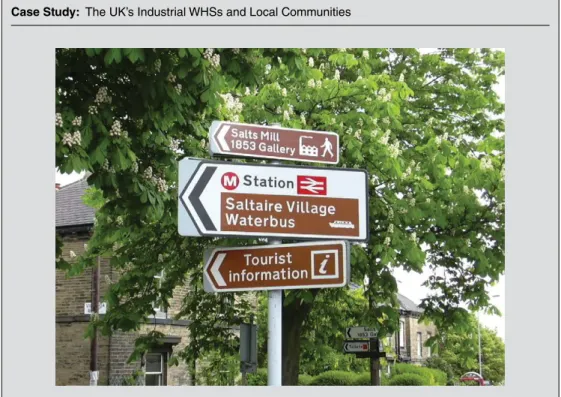
Tourism balance of payments The balance of payments account for a country
However, direct economic effects cover only a small part of the economic effects of tourism since. Furthermore, the expenses of employees in the tourism industry are understood as the induced economic consequences of tourism.
National, local and household income
Tourism industry' describes the direct impact of travel demand associated with tourism services, including transport, accommodation, catering, attractions and entertainment (Page and Connell, 2014) and this can be seen as the direct economic impact of tourism. Such businesses include utilities (eg water), retailers (eg supermarkets) and security (eg nightclub security services) and are considered the indirect economic impact of tourism.
Variety of local businesses, dependency on tourism and
Although most local residents benefit indirectly, it is difficult for them to feel that tourism is financially beneficial to them. However, it should be remembered that an increase in the income of local authorities from tourism does not always lead to an increase in the income of the local population from tourism.
Employment
Furthermore, tourism can also protect existing jobs in the tourism and relevant industries (Sharpley and Sharpley, 1997) and can offer young people and/or women in traditional societies job opportunities (Jimura, 2007a). Furthermore, tourism-related employment opportunities are viewed positively by local people in some destinations (e.g. Jimura, 2007a).
Inflation and increase in the cost of living
Perhaps, the number and types of jobs that tourism has created would be the most significant data to assess the impacts of tourism; however, even these jobs are likely to be spread across different sectors both within and outside the tourism industry; therefore, they cannot be easily identified (Law, 1993). Indirect employment – jobs created within the tourism supply sector, but not as a direct result of tourism activity; and.
Leakage and tourism multiplier Leakages of tourist expenditure from the national,
Induced employment – jobs created as a result of tourism spending, as local residents spend money earned from tourism. In terms of income, the tourism multiplier indicates how much income is generated by a certain amount of visitor spending.
Access to funding
Multinational corporations (MNCs) are a prime example of foreign investors and foreign ownership of tourism-related businesses such as accommodation. In order for tourism to be economically beneficial for local communities, regions or countries, the amount and share of economic benefits from tourism must be increased as long as possible and circulated within them as long as possible.
Financial support from governments and private organizations
In addition, the WH Committee, at its 40th session in 2016, decided to initiate a consultation process on the annual WHS fee on a voluntary basis by asking the Secretariat to send a survey to States Parties and their local governments. responsible for WHS management to obtain feedback on the issue of payment of the WHF annual fee, subject to their financial autonomy and ability to pay, and report to the WH Committee (WHC, 2017a).
Diversity and strength of local economy
This can also lead to an increase in the amount of investment from public and private organizations. Local residents' views of changes in the diversity of local businesses and the strength of the local economy in WHS since the listing of WHS have been examined by researchers.
Employment opportunities
They believe that employment opportunities for local residents have increased following WHS listing in and around the WHS; and accommodation, restaurants, cafes and souvenir shops have created job opportunities for the local population. In summary, it can be stated that WH status and tourism since WHS listing can increase employment opportunities for local residents in and around WHSs.
Income
In and around WHS Saltaire, 54.7% of respondents believed there had been no changes in employment since the WHS designation, although 32.7%. said they had risen and 1.3% thought they had risen a lot. In fact, 58% of respondents are engaged in tourism-related jobs, such as restaurants, but only 29% are satisfied with their tourism income (Xiang and Wall, 2015).
Cost of living
Therefore, the impact of tourism after WHS listing and WH status on the increase in the cost of living seems to be limited. However, tourism at WHS is seen as enclave tourism; therefore, the benefits of tourism to local communities are limited.
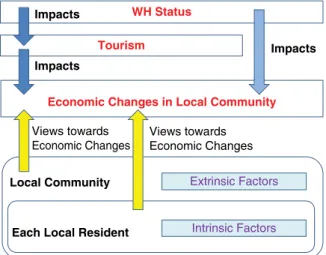
Quality of life and social pathology
For example, Nash (1996), an anthropologist, argues that culture characterizes people's actions, while Giddens (1989), a sociologist, argues that culture is the way people live. Culture is also evident in the tangible and intangible productions of people.” This definition is in the context of her study of race and education.
Overcrowding, privacy and traffic-related problems
The term 'way of life' is also referred to by Griffin (2002) and he argues that culture represents the way of life, advantages and values of a certain group of people. According to Yosso (2005, p. 75) 'culture refers to behavior and values that are learned, shared and exhibited by a group of people.
Population, social polarization and solidarity
Culture' is difficult to define as it includes many complex ideas (Cohen, 2009) and is used in many different contexts (Nash, 1996). As stated by Zald (1996), a sociologist, and van Gorp (2007), whose areas of expertise include media studies, culture refers to an organized set of beliefs, codes, myths, stereotypes, values, norms and frames shared in the collective memory of a group or society.
Local culture
Authenticity
This change can be considered to damage the authenticity of the house if the originality of physical elements is considered an indispensable factor required for authenticity.
Visible atmosphere
Conservation
As of August 2017, these activities appear to make a reasonable contribution to the revitalization of these rural areas, although their effectiveness in the long run cannot be confirmed at this time. Conversely, tourism can also lead to heritage conservation challenges, such as degradation of the built environment and damage to plants.
Recognition and image Tourism and destination marketing are vital to
Communications and cultural exchanges between local residents
Split between the WHS and its surrounding communities
In general, local people living outside the WHS seem to have mixed feelings towards the WHS and people who lived there. Nevertheless, the benefits that local communities outside the WHS can derive from WH status appear to be much more limited than those in the WHS.
Conservation after World Heritage Site inscription
Being a buffer zone means that local communities in the area would still have a certain level of restrictions, such as limited development of new infrastructure. Encouraging the participation of local populations in the conservation of their cultural and natural heritage (UNESCO World Heritage Center (WHC), 2017a).
Conflicts of interests, aspirations and concerns
Across different WHSs, local residents' views on the changes in levels of vandalism, crime and littering since WHS listing do not seem to indicate a clear consensus. Their study reveals that villagers' views on the beauty of the environment in the local community are mixed.
Congestion and privacy
The views of local people about the changes in the feeling and spirit of local communities since WHS designation also appear to be different by WHS. In and around WHS Saltaire, 63.3% of survey participants felt that the feeling and spirit of local communities had not changed since WHS's listing (Jimura, 2007).
Level of conservation
In and around WHS Ogimachi, 44.6% of residents survey participants believe that the level of preservation of the cityscape, including WHS, has declined, and only 12.6%. Local specialists estimate that several buildings and streets, including the components of the WHS, have been renovated since the WHS listing (Jimura, 2007).
Interactions between local people and visitors
The impact of World Heritage designation on local communities - a case study of Ogimachi, Shirakawa-mura, Japan. 2008) Socio-cultural effects of tourism on the rural areas within the World Heritage Sites - the case of KwaZulu-Natal, South Africa.
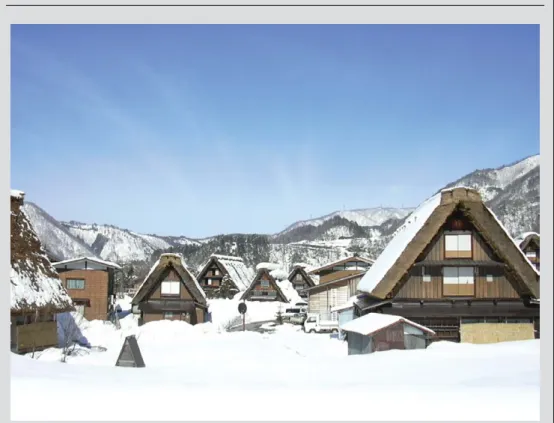
Introduction
Considering the focus of existing studies, in general, the natural environment has attracted more attention than the built environment, and the impact of tourism on the environment can be positive or negative for local communities (eg Holden, 2016). In general, however, the environmental impacts of tourism on local communities tend to be negatively understood.
Natural environment
This section uses these categories to explore the negative impact of tourism on the natural environment. Pollution is another negative impact of tourism on the natural environment associated with the development of tourist destinations.
Built environment: infrastructure Of diverse components included in the built en-
Nevertheless, the number of visitors to the islands is still high, reaching 140,000 by the mid-2000s (Galapagos Conservancy, n.d.a.). Of the six threats listed by The Guardian (2014), invasive species and climate change are considered by the WHC (2017a) to be primary factors affecting the OUV of WHSs.
Invasive species
Regarding TIC, Ispas et al. 2014) examine TIC roles for Brasov (Romania) and compare them with TIC roles in Riga (Latvia), Girona (Spain) and Manhattan (USA). Of the six threats to natural WHS highlighted by The Guardian (2014), tourism is covered in section 1 and logging as deforestation in section 1.2.2.
Poaching
Various measures have been implemented for the eradication of these species, taking into account the consequences of such removal (e.g. Glen et al., 2013). The importance of such a consideration is noted by Bergstrom et al. 2009) through their study on Macquarie Island (WHS Macquarie) (natural WHS in Australia).
Dams
Animals and plants introduced to WHS Galapagos pose the greatest threat to WHS ecosystems (Galapagos Conservancy, n.d.b). To give an example, the construction of the Three Gorges Dam (China) caused displacement and resettlement of local people who had lived in the planned areas (Heggelund, 2017).
Climate change
In the case of Tasmania Wilderness (natural WHS in Australia), the WHS designation of the site was proposed by the Tasmanian state government to stop the construction of a massive dam (Sullivan, 2004). In the case of WHS Ogimachi, 40% of the local people involved in the survey believed that the local natural environment has.
Built environment at WHSs
Three of the seven experts suggested an indirect negative effect of WHS listing on the local natural environment. The study on Ha Long Bay (WHS Ha Long Bay) (Natural WHS in Vietnam) by Long (2012) shows neither positive nor negative views of local residents about the impact of tourism on the local natural environment.
Built environment at WHSs
Host community perceptions of tourism impacts: a case study on the World Heritage city of Safranbolu, Turkey. A discussion of World Heritage Sites (hereinafter WHSs) encompasses several issues, both within and around their conceptual framework.
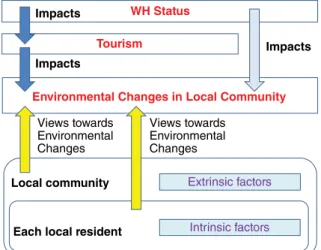
The List of World Heritage in Danger The LWHD was invented to inform the interna-
1 Severe deterioration of materials Modification of the legal status of the property by reducing the degree of its protection 2 Serious deterioration of the structure and/or. 3 Trespassing of people on the borders or upper areas that threaten the integrity of the property.
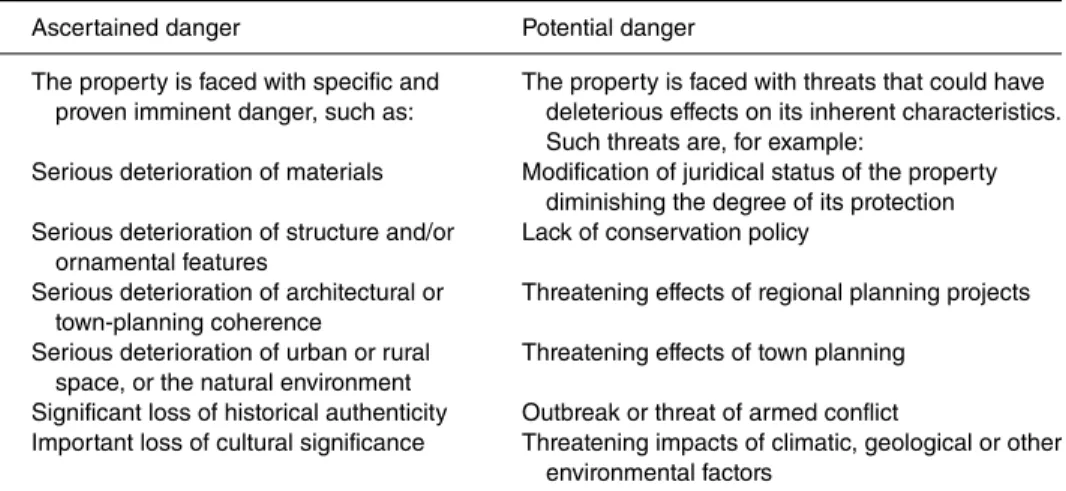
Cultural Landscapes
The distribution of WHSs listed as cultural landscapes appears to be relatively well balanced across regions of the world. The Dresden Elbe Valley, one of the two areas to lose WH status, was also listed as a cultural landscape.
Historic Urban Landscapes Because of its implications with the concepts of
To enable the preservation of the world's documentary heritage with the most appropriate techniques. The principle for the implementation of the WHS concept is the WH convention, and for the ICH idea the ICH convention;.
Nature-focused concepts
Available at: http://www.unesco.org/new/en/communication-and-information/memory-of-the-world/register/ (accessed 29 October 2017). The concept of World Heritage Sites (WHSs) is one of UNESCO's core initiatives for the preservation of cultural and natural heritage at the international level.
Historical backdrops and essential information
WH) The Committee is an intergovernmental committee that aims to protect cultural and natural heritage of outstanding universal value (OUV) (WHC, 2017b). The WH Committee is supported by official advisory bodies: the International Council on Monuments and Sites (ICOMOS), the International Center for the Study of Conservation and Restoration of Cultural Property (ICCROM) and the International Union for the Conservation of Nature (IUCN) (WHC, 2017c).
World Heritage Convention and mission of World Heritage Sites
Inscription of World Heritage Sites
Concept of World Heritage Sites and Outstanding Universal Value
Thus, the concept of authenticity in the context of WHSs could also differ slightly from these definitions. Therefore, it is advisable for UNESCO to review the concept of authenticity referring to the current key arguments about this concept in academia and in the real world when they update the operational guidelines.
Societies and communities Asian societies such as Japan tend to be more
WHC, 2017i) Like concepts of heritage, there are divergent notions of authenticity between the academy and the. Western views, especially Europe and North America, were well reflected in the WH Convention, the attributes on the WHL and the operational guidelines in the 1970s and 1980s (see Section 3 in Chapter 1).
Culture and religion
Regarding 'authenticity', WHC (2017i) states that, depending on the type of cultural and mixed heritage and their cultural background, nominated properties can be understood to meet the condition of authenticity if their cultural values are expressed in a way directly. - in an advanced and convincing manner through the following attributes:. traditions, techniques and management systems; language and other forms of intangible heritage; other internal and external factors. To this end, this section summarizes Section 7 in Chapter 1 to demonstrate Eastern and Western views of topics related to WHSs, with particular reference to Japan and the UK.
Heritage and authenticity
In terms of authenticity and heritage, attitudes towards them may differ between the west and the east (eg UK and Japan). The desire for Western culture and heritage would be the main reason why copies of Western architecture were built in the east; however, Westerners may feel that these copies represent the native's loose approach to heritage authenticity and lack of respect for authenticity.
Conservation: culture and nature As for conservation of cultural and natural her-
The former probably believes that preserving tangible elements of heritage is essential to preserve the authenticity of heritage, while the latter tends to value intangible aspects of heritage more, such as the spirit of place (Jimura, 2007). Ashworth and Tunbridge (2000) argue that Japan's lax attitude towards heritage authenticity could be a reason for Japan's passion for replica construction.
Cities and planning
Indeed, many replicas of Western buildings and cityscapes have been made in Japan. However, it should not be concluded that the Eastern attitude towards authenticity is looser than the Western one.
Tourism
The extent of the heterogeneity of societies and cultures in the world must be sufficiently recognized in order to preserve social and cultural diversity. The concept of sustainable development gained international attention in the 1980s, and its fundamental principle is to achieve the triple bottom line (TBL) (economic, sociocultural and environmental) sustainability.
World Heritage Sites: tourism marketing
Direct and indirect, visible and invisible benefits of WH status and tourism development should be recognized by local communities. WHS status and tourism can trigger several changes in local people's minds after WHS designation.
Introduction
However, as a member of a tourist destination that is or has a WHS, they should also take their responsibility for WHS conservation and tourism through their business. To this end, a community-based and 'glocal' approach should be adopted in WHS conservation and tourism at the local level.
Economic changes
Of these, (iv) pride in the place of residence can be understood as the strongest change occurring in the minds of local people after the inscription of the WHS. In general, the financial benefits of tourism and/or WH status seem not to be recognized by local residents who are not engaged in tourism businesses.
Sociocultural changes
Furthermore, according to local people's view, local businesses tend to be more diversified only at WHSs where their core industries were not tourism before WHS designation. It is regrettable that ties between local people can in some cases be weakened by WH status and/or tourism.
Environmental changes Relative to economic and sociocultural impacts
2003) Visitor management - as a professional responsibility of different site managers (Maritime Greenwich - World Cultural Heritage). Criteria for Selection Integrity of Universal Value and Authenticity World Heritage Status. tourism, local communities and nature conservation activities.
